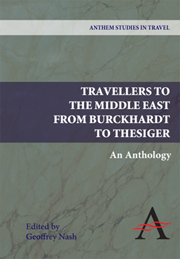Book contents
- Frontmatter
- Contents
- Acknowledgements
- Introduction
- PART ONE THE COMING OF EMPIRE 1800–1879
- The Ottoman Empire and Egypt
- Arabia
- 1 Travels in Arabia
- 2 Travels in Arabia
- 3 Personal Narrative of a Pilgrimage to Al-Madinah and Meccah
- 4 Narrative of a Year's Journey Through Central and Eastern Arabia
- 5 A Pilgrimage to Nejd
- 6 Travels in Arabia Deserta
- Persia
- PART TWO COLONIALISM AND RESISTANCE 1880–1950
- Bibliography
4 - Narrative of a Year's Journey Through Central and Eastern Arabia
from Arabia
Published online by Cambridge University Press: 05 March 2012
- Frontmatter
- Contents
- Acknowledgements
- Introduction
- PART ONE THE COMING OF EMPIRE 1800–1879
- The Ottoman Empire and Egypt
- Arabia
- 1 Travels in Arabia
- 2 Travels in Arabia
- 3 Personal Narrative of a Pilgrimage to Al-Madinah and Meccah
- 4 Narrative of a Year's Journey Through Central and Eastern Arabia
- 5 A Pilgrimage to Nejd
- 6 Travels in Arabia Deserta
- Persia
- PART TWO COLONIALISM AND RESISTANCE 1880–1950
- Bibliography
Summary
Adopting the diverse roles of spy, missionary, and Arabian explorer, like his contemporary Burton, Gifford Palgrave was an outsider who travelled both in order to test himself and in pursuit of an identity. Brought up in a conventional Anglican household though half Jewish through his father, Palgrave enjoyed a controversial reputation during his lifetime owing to perceived disloyalty to his country. After a brilliant academic career at Charterhouse and Oxford he surprised his family by giving up his studies to join the army in India in 1847. An even greater shock ensued when he converted to Catholicism and became a Jesuit in South India in March 1848, staying at Jesuit College, Negapatam, and then Collegio Romano, Rome until 1855. In the same year he travelled to Syria as Father Michel Sohail, where he witnessed in 1860 the massacre of Maronite Christians during their conflict with the Druze. By now well versed in Arabic language and culture, he went to Arabia as an agent of Napoleon III in the disguises of a Syrian doctor/merchant. He set out from Ma'an in June 1862 and traversed the heart of Central Arabia to Ha'il via Djowf and Jebel Shammar, then went on to Riyadh from where he crossed the Dahna desert to Hufuf, sailing around the northern coasts of Bahrain. Here Palgrave departed from his travelling companion, continuing to Qatar then through the straits of Hormuz, completing his journey in Muscat.
- Type
- Chapter
- Information
- Travellers to the Middle EastAn Anthology, pp. 65 - 72Publisher: Anthem PressPrint publication year: 2009



